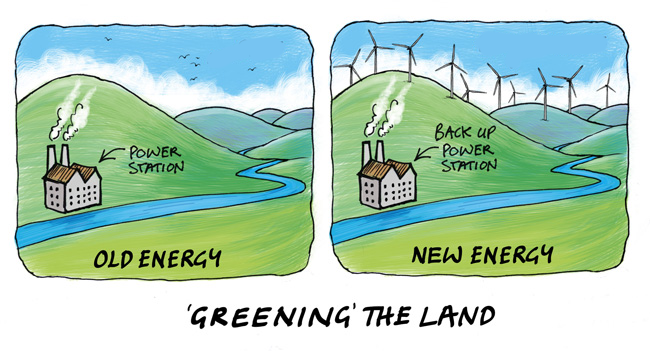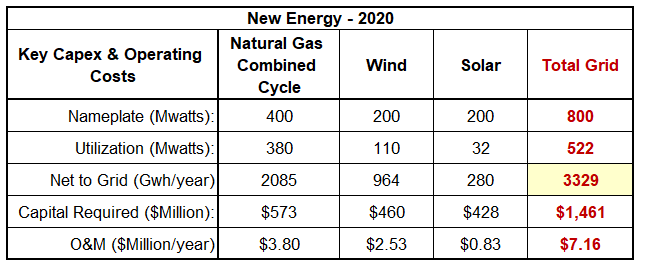Economics 101 - Renewable Energy
The MD of Willowdale is a typical municipal district in Canada populated by a cross section of Canadians. The majority of people live in town, but there are many rural residents.
It is a prosperous community thanks to a cheap and reliable source of electricity provided by a Natural Gas Combined Cycle (NGCC) power plant.
- Total electrical demand is 3329 Gigawatt hours per year.
- The 400 Mw NGCC power plant cost $573 Million to build. It is very reliable and has never failed.
- Operating and Maintenance (O&M) Costs are $3.8 Million per year.
- Electricity prices are low, but the power plant enjoys a reasonable 10% return on investment which can support upgrades to the latest emission controls.
The power distribution system is simple and inexpensive to operate supporting low electricity prices.

In 2018 the Canadian Government and an ill-informed public forced the MD of Willowdale to add Wind and Solar power generation.
- Total electrical demand remains at 3329 Gigawatt hours per year which under normal circumstances would not justifying adding addition power generation.
- Several wind farms were added for a total 200 Mwatts of nameplate capacity. Local conditions limit power production to 55% of nameplate capacity. The power is not reliable and frequently drops to near zero for several days.
- In addition, several solar farms were added to the grid for a total of 200 Mwatts of nameplate capacity. Due to the northern latitude of the district and local weather patterns, power production is limited to 16% of nameplate capacity. Like wind power, solar is unreliable during the day and zero at night.
- Because there was no economic basis to install the wind and solar, substantial government subsidies were required to entice the companies to build the plants.
- To force residents to accept the new renewable facilities, the government has added an escalating $20/tonne Carbon Tax. This increases the cost of electricity from the Natural Gas plant. It does not cause people to cut back consumption, but does provide additional revenue for the government who spends it outside the MD of Willowdale. Often to promote their political agenda.
- The facilities also sell Renewable Energy Certificates (RECs). For each Mwatt generated, the company is paid a fee to subsidize operating expenses. These RECs are then resold to companies to allow them to say they are "reducing emissions". This allows them to comply with government regulations, but no actual reduction in GHG emissions occur because the wind and solar farms would produce the energy anyway. It is a scam of Enron proportions that allows people to profit from something that does not exist and is never delivered.
The "New Energy System" is much more complex and costly, but total generation remains the same (3329 Gwh/yr).

- Total Capital Invested has increased by $888 Million to $1,461 Million. Although some of this was covered by government subsidies, the balance must be paid for through higher electricity prices. The taxpayer will eventually pay for the subsidies.
- Operations and Maintenance costs have increased by $3.36 Million per year. This must be added to the consumer cost of electricity.
- The companies sell RECs, but this does not necessarily affect O&M costs. The majority goes to profit for the companies owning the wind and solar farms.
- Electricity prices have increased by 60% since the renewable energy has been added. Everyone's monthly utility bill has increased substantially resulting in less disposable income. Businesses are forced to pass on the increase to the consumer as higher prices for goods and services.
The residents of the MD of Willowdale are now paying more for electricity as well as goods and services in the community. This is all so that a few people can feel good that they have cut Green House Gas Emissions by a very small and insignificant amount. To understand why cutting CO2 emissions does not benefit Canadians, check out www.goinggreencanada.ca
An Analogy to Renewable Energy.....
You already own a very nice car worth $20,000. It looks and runs great and has many years of life remaining. It meets your needs perfectly.
The government and some ill-informed neighbors tell you that you must buy a second car for $50,000.
- The new car looks nice but will only run a few hours each day. Some days, it will operate for 6 hours, some days for 4 hours and occasionally will not run at all.
- The new car is very unreliable. Even when it runs, you never know when it will come to a stop or slow down to a walking pace. Occasionally, the slowdown can last for several days. When this happens, you must call your partner to come pick you up in the old car.
- Because you cannot rely on the new car, you must keep the old car as there are many times you cannot be late (i.e. for work).
- Your cost increase substantially. Even though part of the price of the new car was paid for by a subsidy (i.e. the taxpayer), you still have a larger monthly payment as well as needing to maintain 2 vehicles.
Would you be happy about buying the second car?
Download a PDF summary of this page
The costs shown are just a subset of the total economic impact. They have been abbreviated to simplify the explanation but are directionally correct. Source: Canadian Energy Research Institute


